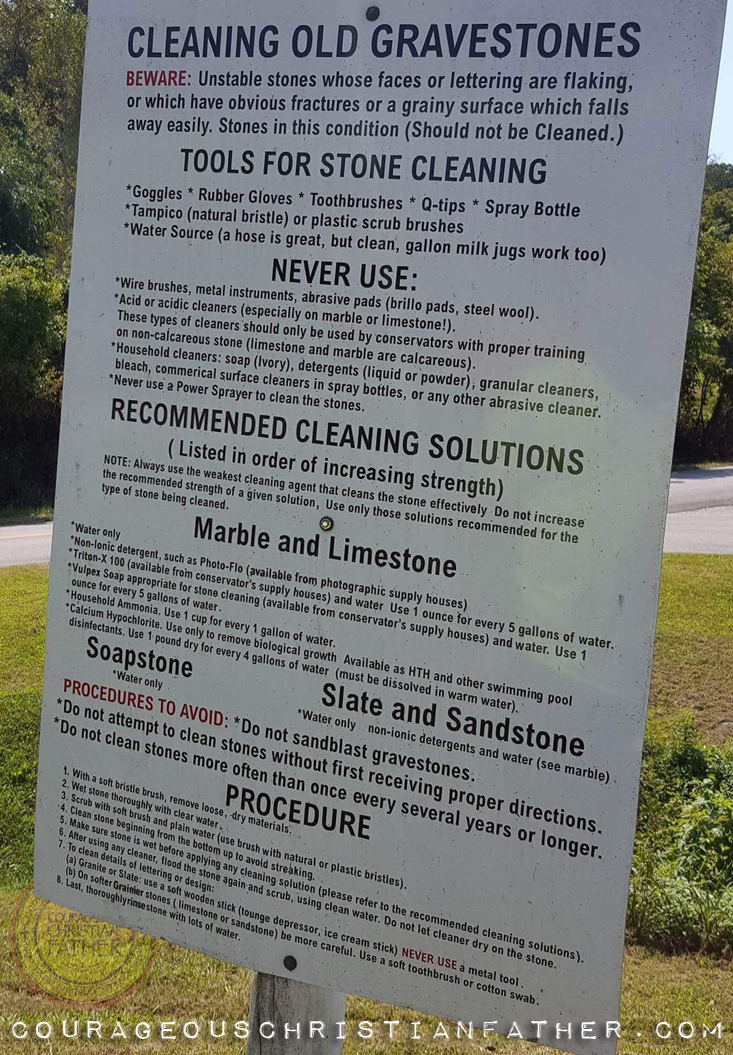Cleaning Old Gravestones. Some care must be taken when you go to clean old gravestones. You must also take in consideration the type of gravestone used too.
Cleaning Old Gravestones
While on an outing with Heather of SimplySpokn, we visited Red Bird Baptist Church in Williamsburg, KY on September 8, 2017. I saw this sign about cleaning old gravestones. I figured I would share with my readers what this sign says. In a previous post, I shared about Gravestone Symbols. These are symbols you would see on gravestones.
BEWARE: unstable stones whose faces or lettering are flaking, or which have obvious fractures or a grainy surface which falls away easily. Stones in this condition (Should not be Cleaned.)
Tools for Stone Cleaning
- Goggles
- Rubber Gloves
- Toothbrushes
- Q-Tips (Cotton Swab)
- Spray Bottle
- Tampico (natural bristle) or plastic scrub brushes
- Water Source (a hose is great, but clean, gallon milk jugs work too) [You could reused water bottles too]
Never Use:
- Wire brushes, metal instruments, abrasive pads (brillo pads, steel wool)
- Acid or acidic cleaners (especially on marble or limestone!)
- These types of cleaners should only be used by conservators with proper training on non-calcareous stone (limestone and marble are calcareous)
- Household cleaners:
- Soap (Ivory)
- Detergents (Liquid or powder)
- Granular Cleaners
- Bleach
- Commercial Surface Cleaners in Spray Bottles
- or Any other abrasive Cleaner
- Never use a power sprayer to clean the stones
Recommended Cleaning Solutions
(Listed in order of increasing strength)
NOTE: Always use the weakest cleaning agent that cleans the stone effectively. Do not increase the recommended strength of a given solution. Use only those solutions recommended for the type of stone being cleaned.
Marble and Limestone
- Water Only
- Non-Ionic detergent, such as Photo-Flo (Available from photographic supply houses)
- Triton-X 100 (Available from conservator’s supply houses) and water (use 1 ounce for ever 5 gallons of water)
- Household Ammonia (Use 1 cup for every 1 gallon of water)
- Calcium Hypochlorite (Use only to remove biological growth – Available at HTH and other swimming pool disinfectants. Use 1 pound dry for every 4 gallons of water – Must dissolve in warm water.)
Soapstone
- Water Only
Slate and Sandstone
- Water Only (Non-ionic detergents and water – See Marble above)
Procedures to Avoid
- Do not sandblast grave stones
- Do not attempt to clean stones without first receiving proper directions
- Do not clean stones more often than once every several years or longer
Procedure
- With soft bristle brush, remove loose, dry materials
- Wet stone thoroughly with water
- Scrub with soft brush and plain water (use brush with natural or plastic bristles)
- Clean stone beginning from the bottom up to avoid streaking
- Make sure stone is wet before applying any cleaning solution (please refer to the recommended cleaning solutions)
- After using any cleaner, flood the stone again and scrub, using clean water. do not let cleaner dry on the stone
- To clean details of lettering or design
- Granite or Slate: use a soft wooden stick (tongue depressor, ice cream stick) NEVER USE a metal tool
- On softer Grainier stones (limestone or sandstone) be more careful. Use a soft toothbrush or cotton swab (Q-Tip)
- Last, thoroughly rinse stone with lots of water.

More Tips?
Do you have any tips for cleaning graves you want to share? Please feel free to share in the comments below.
| Gravestone Symbols | Tent Graves | Cleaning Old Gravestones |
About the Author
Discover more from Courageous Christian Father
Subscribe to get the latest posts sent to your email.


